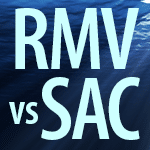 Few topics seem to generate more confusion among divers and instructors than Respiratory Minute Volume, better known as RMV, and Surface Air Consumption rate, commonly referred to as SAC rate. This article will tell you what you need to know in simple, easy-to-understand language.
Few topics seem to generate more confusion among divers and instructors than Respiratory Minute Volume, better known as RMV, and Surface Air Consumption rate, commonly referred to as SAC rate. This article will tell you what you need to know in simple, easy-to-understand language.
Here are some of the things I’ve had tech Instructor candidates tell me when I asked them to explain the difference between the two:
- One is metric; the other imperial
- You measure SAC in psi and RMV in cubic feet
- RMV is for CCR diving; SAC is for open circuit
Of course, everyone of these statements is wrong. Dead wrong.
It doesn’t help that, in many tech diver courses, any discussion of RMV and SAC rate is coupled with a lot of complex math. In reality, the underlying concept is actually fairly simple.
A friend of mine, former Dive Training magazine Senior Editor Dr. Alex Brylske, is fond of saying:

Let’s see if we can do just that.
Respiratory Minute Volume
Respiratory Minute Volume or RMV is exactly what the name implies: The volume of gas, in either liters or cubic feet, that moves in to or out of your lungs over the course of a minute. Note that it doesn’t matter whether you use metric or Imperial units of measure — so just use whatever you are most comfortable with.

Open-circuit and CCR divers use RMV for very different purposes.
- For open-circuit divers, RMV is a way of projecting gas consumption at depth.
- CCR divers, on the other hand, don’t “consume” gas the way open-circuit divers do. They use RMV chiefly for projecting scrubber canister life. The lower the RMV, the less carbon dioxide passes through the scrubber material, and the longer it will last.
In this article, we’re going to focus on how RMV affects open-circuit divers.
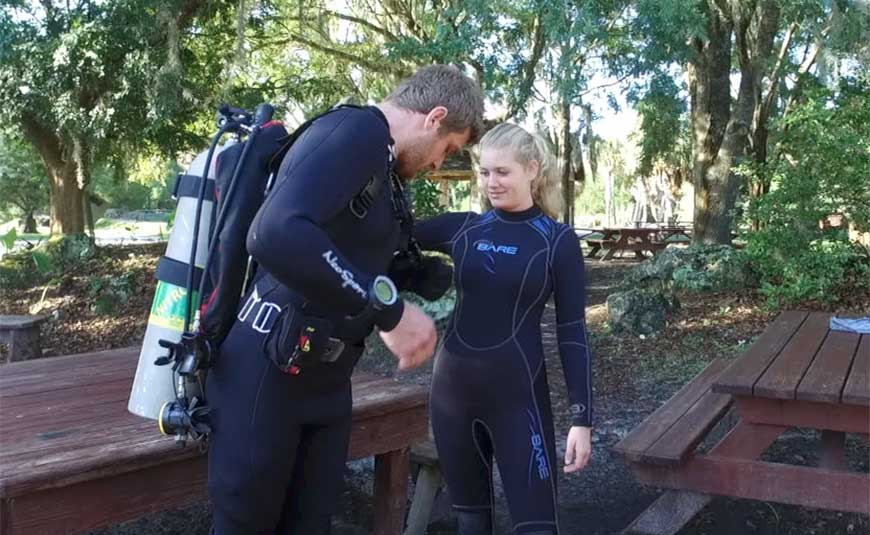
It’s possible for open-circuit divers to measure RMV in bars or psi — but this is only useful if, like many sport divers, you consistently use just a single size cylinder, like an 11-liter Aluminum 80.
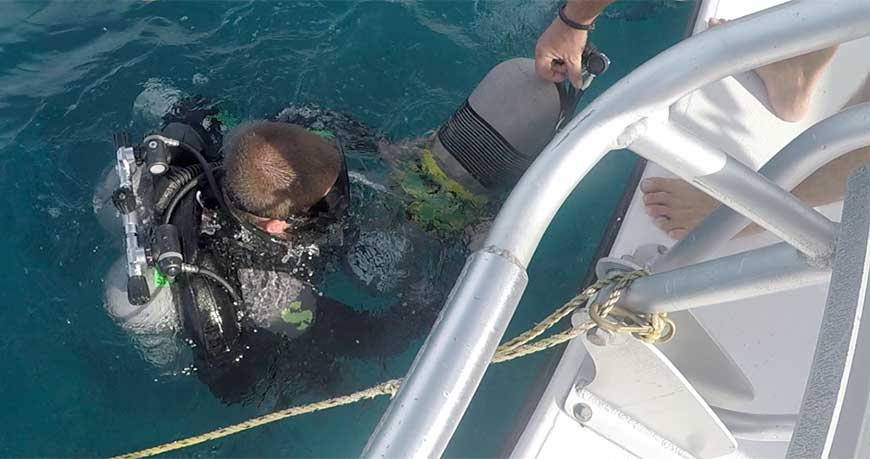
As cave and technical divers, we use a wide variety of cylinders. Therefore, it’s important for us to be able to project RMV in terms of volume, so that we can apply it to any size cylinder we may happen to be using.
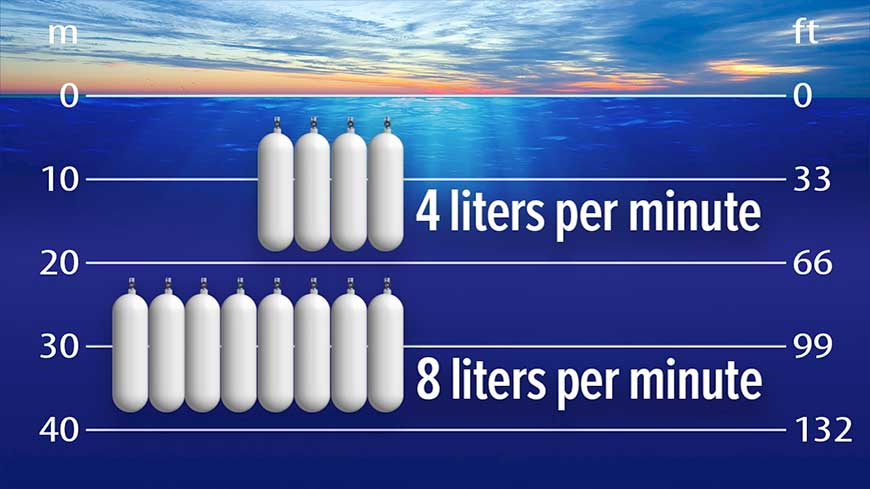
The thing about RMV is that it varies with depth. For example, at a depth of four atmospheres — that’s 30 meters or just under 100 feet — our RMV will be twice what it would be at a depth of two atmospheres or ten meters/33 feet. This is just Boyles law in action.
In order to make RMV usable, we need to convert it to something else. This is where Surface Air Consumption or SAC rate comes in.
Surface Air Consumption (SAC) Rate
SAC rate is nothing more than RMV adjusted for ambient pressure at sea level. In other words, if your RMV at a depth of four atmospheres is eight liters per minute, it means your SAC rate is one fourth of that, or two liters per minute.
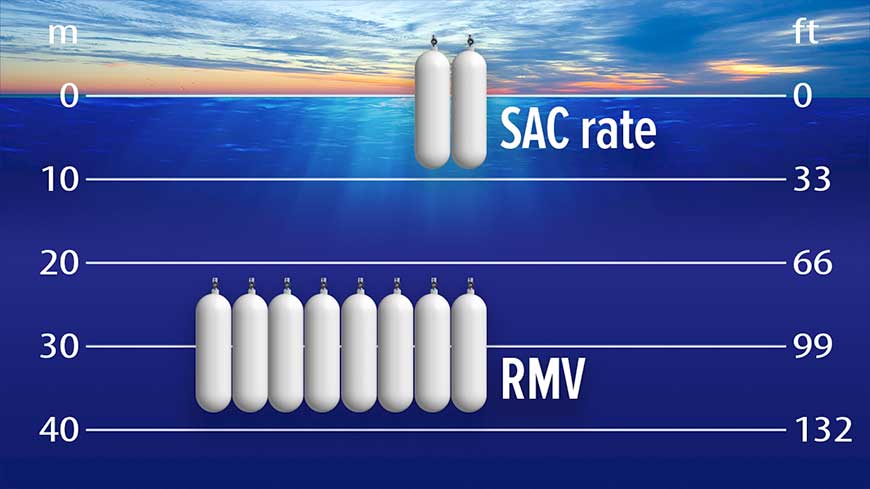
Determining your personal SAC rate isn’t difficult, but you will need to spend a little time doing it.
- Basically, you are going to need to do a number of gas-consumption runs. The reason you do several of these is that your gas consumption will vary each time you do one, and you need to be able to average them to come up with a more accurate figure.
- A typical gas-consumption run consists of swimming or resting at a constant depth for a fixed period time. Five minutes or more is common. If you use, say, 35 bars or 500 psi over a period of five minutes, your RMV at depth would be one fifth of that. This works out to seven bars or 100 psi per minute.
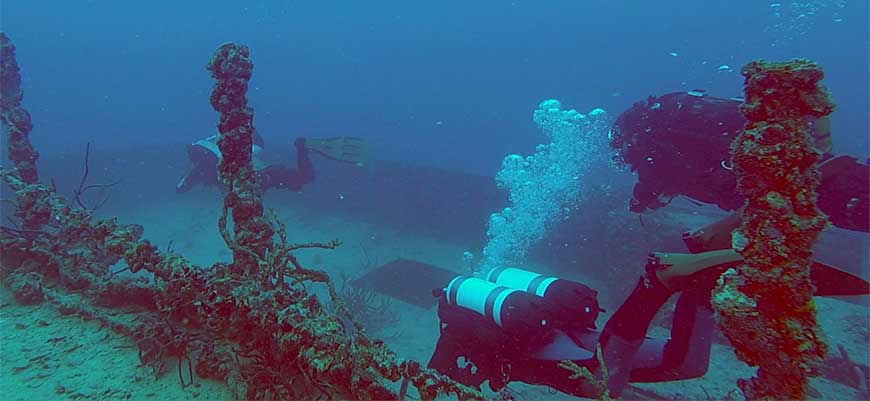
- The next step is to convert RMV to an equivalent Surface Air Consumption rate by dividing it by the depth of your run in Atmospheres Absolute (ATA). So, again, if you did your gas consumption run at a depth of 10 meters or 33 feet, your SAC rate would be half what it was at depth.
If you don’t remember the formula for converting depth in meters or feet to ATA, no sweat. Here it is:

- The final step is to convert these values from pressure to volume by factoring in the size and working pressure of whatever cylinder you were breathing from.
Okay, there is a lot of math here, but we’re going to make it easy on you. At the end of this article, you’ll find links to metric and imperial versions of our SAC Rate Calculator spreadsheets.
![SAC calculator]](https://cavediverharry.com/wp-content/uploads/2017/09/09-SAC-calculator.jpg)
All you have to do with these spreadsheets is plug in your starting and ending pressures, the depth and time of your gas consumption run, and the working pressure and rated capacity of the cylinder you were breathing from. (Just remember to multiply the rated volume by two if using doubles.)
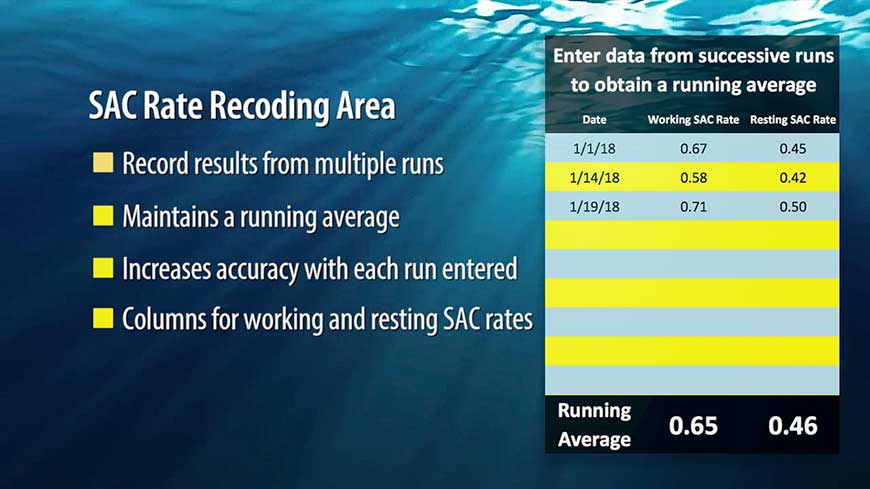
Along with the calculator portion of each spreadsheet, there is a recording area to list the results from multiple consumption runs. The spreadsheet then gives you a running average that increases in accuracy the more runs you do.
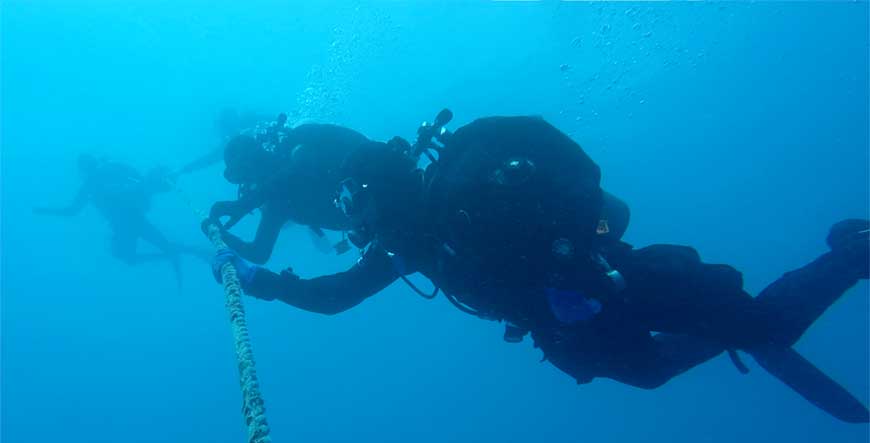
The record area also has separate columns so that you can record your results for both the working and resting portions of a dive. Let’s face it: Your RMV is going to be a lot higher when you are fighting against a current that it will be when you are hanging off a line doing deco. You need both values.
Using SAC Rate in the Real World
The more you can refine your SAC rate values by making and recording multiple gas consumption runs, the more valuable they will become in real-world dive planning. Again, the steps for doing so are not that complicated.
- To start, you will need to know — or at least be able to estimate — the average depth of an upcoming dive.
- Next, convert this depth to Atmospheres Absolute or ATA.
- Now, multiply your SAC rate by your depth in ATA and again by the number of minutes you plan to remain at this depth.

This will give you a projected volume in liters or cubic feet.
- The final step will be to factor in the size of your cylinders to convert this value to a specific number of bars or psi.
Cave and technical dives are almost always multilevel dives. This means that, depending on the complexity of the dive, you may need to do a gas-use projection for each deco stop and, possibly, each phase of your time on the bottom, if it will be at differing depths.
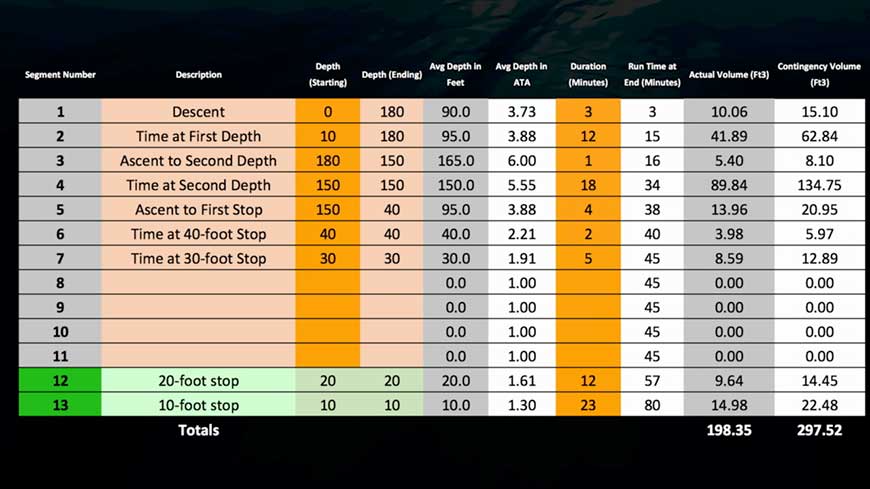
Don’t worry. We have a spreadsheet for that, too. But that’s a topic for another video and another blog article.
Busting the Myths
If you didn’t already have a good grasp of RMV and SAC, you should have a much better understanding now. Let’s recap by busting some of the myths we identified at the beginning of this video.
- You can measure both RMV and SAC using either metric or imperial values. The choice is entirely up to you.
- Although you initially use either bars or psi when measuring RMV, the results are only useful if you convert them from pressure to volume.

- SAC is nothing more than RMV adjusted for ambient pressure at sea level.
- CCR divers use RMV, too — but in a way that is very different from what open-circuit divers do.
On a final note, if you teach cave or technical diving, remember that there is no need to make this complicated. Keep it simple. You’ll increase your students’ understanding and, as a result, make them safer.
Download the SAC Rate Calculator Spreadsheet
 The SAC Rate Calculator spreadsheets are available in both metric and Imperial versions. They come as ZIP format files, which you can usually unzip just by double clicking them. The unzipped files are in Microsoft Excel format.
The SAC Rate Calculator spreadsheets are available in both metric and Imperial versions. They come as ZIP format files, which you can usually unzip just by double clicking them. The unzipped files are in Microsoft Excel format.
